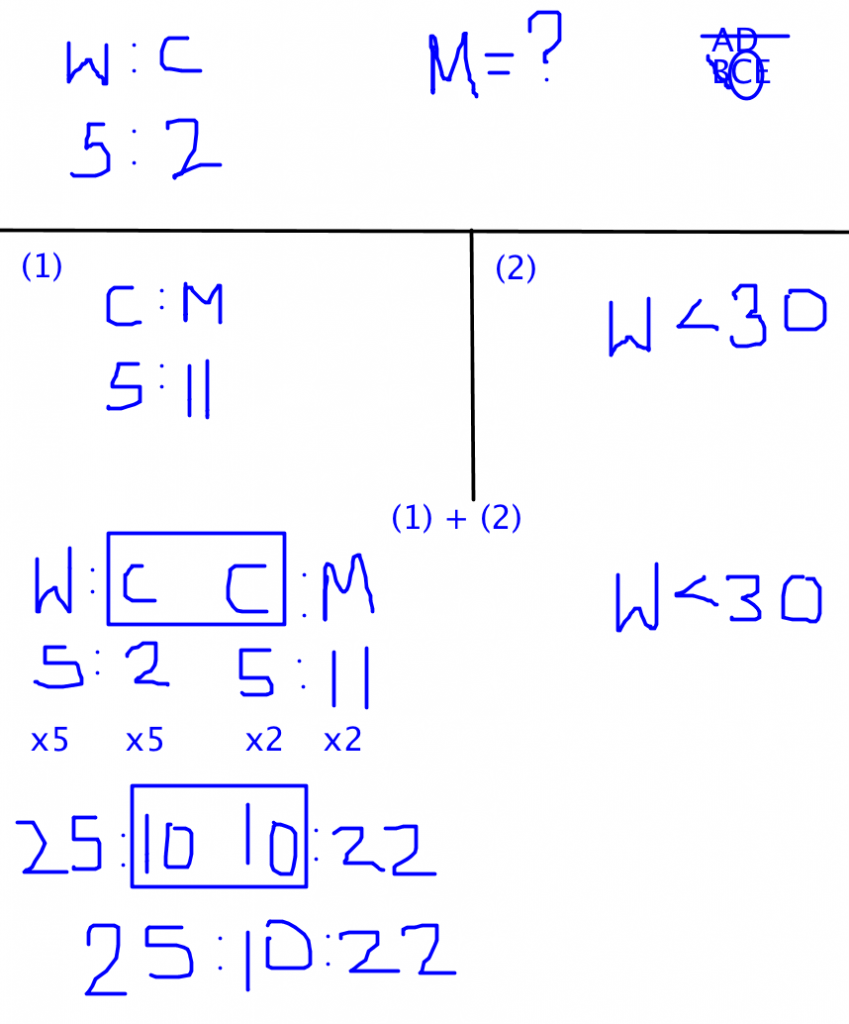-
Target Test Prep 20% Off Flash Sale is on! Code: FLASH20
Redeem
GMAT Data Sufficiency: Ratio Stories
 How are you with story problems? Most math concepts can be presented in story form on the test and the GMAT test writers do like to get wordy with us. Youve got a double task: you have to translate the words into math and then you still have to do the math! How can we get through these as efficiently as possible?
How are you with story problems? Most math concepts can be presented in story form on the test and the GMAT test writers do like to get wordy with us. Youve got a double task: you have to translate the words into math and then you still have to do the math! How can we get through these as efficiently as possible?
Try the GMATPrep problem below and then well talk about it. Give yourself about 2 minutes. Go!
* On a certain sight-seeing tour, the ratio of the number of women to the number of children was 5 to 2. What was the number of men on the sight-seeing tour?(1) On the sight-seeing tour, the ratio of the number of children to the number of men was 5 to 11.
(2) The number of women on the sight-seeing tour was less than 30.
Got your answer? (If youre wondering where / what the answer choices are, click here to learn about Data Sufficiency before proceeding with this problem.)
All right, so W : C is 5 : 2 and they want to knowoh, thats interesting. Theyre asking for the number of men. In other words, there are three groups here, not just two.
 After I write that down, I glance back up at the screen to make sure Ive got everything transcribed correctly. Okay, not much else I can do here. Moving on to statement (1).
After I write that down, I glance back up at the screen to make sure Ive got everything transcribed correctly. Okay, not much else I can do here. Moving on to statement (1).
(1) On the sight-seeing tour, the ratio of the number of children to the number of men was 5 to 11.
Hmm. Theyre giving me another ratio.
Even as Im jotting this info down, Im skeptical. Why?
There are no real numbers here. They didnt ask for the ratio of men to anything. They just want the actual number for M.
Statement (1) is not sufficient. Cross off choices (A) and (D). Next up, statement (2).
(2) The number of women on the sight-seeing tour was less than 30.
Yes! Now theyre giving me a real number! So now I can solve.
Oh, wait. Careful: the question stem doesnt contain any info about the men. This is why I organize my scrap paper in the way that Im showing you: Ive segregated the various pieces of info so that I can catch myself when I might try to use certain pieces of data at the wrong time. Right now, I have to completely ignore statement (1); it doesn't exist. I can figure out some possibilities for the number of women but nothing about the number of men.
Okay, statement (2) doesnt work either; cross off answer (B).
So now we get to use everything. Does that help?
Yes, it does! First, the two different ratios can be combined into one big ratio. To do that, the like portions of the two ratios have to be made the same:
That ratio cant be simplified further, because the 25 is not even but the 10 and 22 are.
Next, there are fewer than 30 women. The women have to represent 25 in the ratio; in other words, the number of women must be a multiple of 25. Theres only one possible multiple of 25 that is also less than 30: 25 itself! There must be exactly 25 women, 10 children, and 22 men. Done!
The correct answer is (C).
One big trap on this problem is assuming that the inequality given for statement (2) wont be enough. The (faulty) thinking goes: the problem asks for a specific value, and a range (less than 30) isnt going to be enough to get to one specific value.
Turns out, in this case, it is! It can be tricky on DS to know when to stop the math; you dont want to have to solve every problem completely or youll take way too much time. In this case, the clues for me were:
(1) Less than 30 isnt all that many possible values
(2) The two like parts of the ratio (children and children) are different enough to start (5 and 2) that the final ratio numbers might end up being quite largeso maybe less than 30 will be good enough after all
Okay, want to try another? Try this GMATPrep problem from the free question set, then join me next time to discuss the solution.
A certain wooded lot contains 56 oak trees. How many pine trees does the lot contain?(1) The ratio of the number of oak trees to the number of pine trees in the lot is 8 to 5.
(2) If the number of oak trees were increased by 4 and the number of pine trees remained unchanged, the ratio of the number of oak trees to the number of pine trees in the lot would be 12 to 7.
Key Takeaways: Work methodically and dont stop too soon!
(1) On story problems, half the battle is translating accurately. Its easy to make careless mistakes (such as reversing two categories), and of course, sometimes the translation is just tricky. After youve translated the story, double-check your notes against the screen to make sure everythings where it should be.
(2) Two ratios can be combined into one, as long as they overlap somewhere. The like category needs to be made the same number for both ratios; then you can combine them into one big ratio.
(3) Dont stop too soon on DS! When they give you a range of possible values, dont automatically assume it isnt enough. See whether there are other constraints in the problem that might narrow down all of the possibilities to just one answer. If so, youve got sufficiency!
* GMATPrep questions courtesy of the Graduate Management Admissions Council. Usage of this question does not imply endorsement by GMAC.
Recent Articles
Archive
- April 2024
- March 2024
- February 2024
- January 2024
- December 2023
- November 2023
- October 2023
- September 2023
- July 2023
- June 2023
- May 2023
- April 2023
- March 2023
- February 2023
- January 2023
- December 2022
- November 2022
- October 2022
- September 2022
- August 2022
- July 2022
- June 2022
- May 2022
- April 2022
- March 2022
- February 2022
- January 2022
- December 2021
- November 2021
- October 2021
- September 2021
- August 2021
- July 2021
- June 2021
- May 2021
- April 2021
- March 2021
- February 2021
- January 2021
- December 2020
- November 2020
- October 2020
- September 2020
- August 2020
- July 2020
- June 2020
- May 2020
- April 2020
- March 2020
- February 2020
- January 2020
- December 2019
- November 2019
- October 2019
- September 2019
- August 2019
- July 2019
- June 2019
- May 2019
- April 2019
- March 2019
- February 2019
- January 2019
- December 2018
- November 2018
- October 2018
- September 2018
- August 2018
- July 2018
- June 2018
- May 2018
- April 2018
- March 2018
- February 2018
- January 2018
- December 2017
- November 2017
- October 2017
- September 2017
- August 2017
- July 2017
- June 2017
- May 2017
- April 2017
- March 2017
- February 2017
- January 2017
- December 2016
- November 2016
- October 2016
- September 2016
- August 2016
- July 2016
- June 2016
- May 2016
- April 2016
- March 2016
- February 2016
- January 2016
- December 2015
- November 2015
- October 2015
- September 2015
- August 2015
- July 2015
- June 2015
- May 2015
- April 2015
- March 2015
- February 2015
- January 2015
- December 2014
- November 2014
- October 2014
- September 2014
- August 2014
- July 2014
- June 2014
- May 2014
- April 2014
- March 2014
- February 2014
- January 2014
- December 2013
- November 2013
- October 2013
- September 2013
- August 2013
- July 2013
- June 2013
- May 2013
- April 2013
- March 2013
- February 2013
- January 2013
- December 2012
- November 2012
- October 2012
- September 2012
- August 2012
- July 2012
- June 2012
- May 2012
- April 2012
- March 2012
- February 2012
- January 2012
- December 2011
- November 2011
- October 2011
- September 2011
- August 2011
- July 2011
- June 2011
- May 2011
- April 2011
- March 2011
- February 2011
- January 2011
- December 2010
- November 2010
- October 2010
- September 2010
- August 2010
- July 2010
- June 2010
- May 2010
- April 2010
- March 2010
- February 2010
- January 2010
- December 2009
- November 2009
- October 2009
- September 2009
- August 2009


